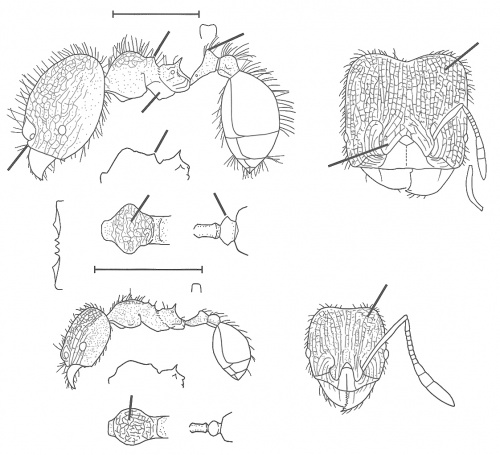Pheidole dyctiota
| Pheidole dyctiota | |
|---|---|
| Scientific classification | |
| Kingdom: | Animalia |
| Phylum: | Arthropoda |
| Class: | Insecta |
| Order: | Hymenoptera |
| Family: | Formicidae |
| Subfamily: | Myrmicinae |
| Tribe: | Attini |
| Genus: | Pheidole |
| Species: | P. dyctiota |
| Binomial name | |
| Pheidole dyctiota Kempf, 1972 | |
Occurs in rainforest (Wilson 2003) and also known from a preserve with disturbed habitat that is adjacent to a hyrdoelectric plant and reservior within the Atlantic forest biome of Brazil (Lutinski et al 2017).
Identification
See the description in the nomenclature section.
Keys including this Species
Distribution
Known only from the state of Sao Paulo, Brazil. (Wilson 2003)
Latitudinal Distribution Pattern
Latitudinal Range: -14.79861111° to -27.22555556°.
| North Temperate |
North Subtropical |
Tropical | South Subtropical |
South Temperate |
- Source: AntMaps
Distribution based on Regional Taxon Lists
Neotropical Region: Brazil (type locality).
Distribution based on AntMaps
Distribution based on AntWeb specimens
Check data from AntWeb
Countries Occupied
| Number of countries occupied by this species based on AntWiki Regional Taxon Lists. In general, fewer countries occupied indicates a narrower range, while more countries indicates a more widespread species. |

|
Estimated Abundance
| Relative abundance based on number of AntMaps records per species (this species within the purple bar). Fewer records (to the left) indicates a less abundant/encountered species while more records (to the right) indicates more abundant/encountered species. |

|
Biology
Castes
Nomenclature
The following information is derived from Barry Bolton's Online Catalogue of the Ants of the World.
- dyctiota. Pheidole dyctiota Kempf, 1972b: 451, figs. 1-5 (s.w.q.) BRAZIL. See also: Wilson, 2003: 682.
Unless otherwise noted the text for the remainder of this section is reported from the publication that includes the original description.
Description
From Wilson (2003): DIAGNOSIS Similar in various ways to Pheidole aper, Pheidole bambusarum, Pheidole brevicona, Pheidole laeviventris, Pheidole lutzi, Pheidole risii, Pheidole rugatula, Pheidole senilis, Pheidole sigillata, Pheidole trachyderma and Pheidole traini, distinguished as follows.
Major: head transversely rectangular, with Head Width 1.1X Head Length; entire dorsal surface of head wholly rugoreticulate except for frontal triangle and mid-c1ypeus, which are smooth; main lines ofrugoreticulum on frontal lobes oriented longitudinally, as illustrated; all of head and meso soma foveolate except mesopleuron, which is smooth; mesonotal convexity subangulate; postpetiole seen from above cone-shaped.
Minor: almost all of dorsal head surface and promesonotal dorsum rugoreticulate.
MEASUREMENTS (mm) Paratype major: HW 1.16, HL 1.08, SL 0.42, EL 0.06, PW 0.60. Paratype minor: HW 0.58, HL 0.58, SL 0.46, EL 0.08, PW 0.38.
COLOR Major: dark reddish brown; appendages medium reddish brown.
Minor: body and mandibles dark reddish brown, almost black; appendages brownish yellow.
Figure. Upper: major (Boraceia Biological Station, Salesopolis, Sao Paulo, 850 m, W. L. Brown) (compared by me with paratype). Lower: paratype, minor. Scale bars = 1 mm.
Type Material
Nova Teutonia, Brazil. Museu de Zoologia da Universidade de Sao Paulo and Museum of Comparative Zoology - as reported in Wilson (2003)
Etymology
Presumably from Gr dictyo-, pertaining to a net; i.e., the rugoreticulum of body surfaces. (Wilson 2003)
References
- Kempf, W. W. 1972d. A study of some Neotropical ants of genus Pheidole Westwood. I. (Hymenoptera: Formicidae). Stud. Entomol. 15: 449-464 (page 451, figs. 1-5 soldier, worker, queen described)
- Lutinski, J. A., C. J. Lutinski, C. Guarda, M. A. Busato, and F. R. M. Garcia. 2017. Richness and structure of ant assemblies (Hymenoptera: Formicidae) in Atlantic forest in southern Brazil. Anais Da Academia Brasileira De Ciencias. 89:2719-2729. doi:10.1590/0001-3765201720160892
- Wilson, E. O. 2003. Pheidole in the New World: A dominant, hyperdiverse ant genus. Harvard University Press, Cambridge, MA. (page 682, fig. major, minor described)
References based on Global Ant Biodiversity Informatics
- Brandao, C.R.F. 1991. Adendos ao catalogo abreviado das formigas da regiao neotropical (Hymenoptera: Formicidae). Rev. Bras. Entomol. 35: 319-412.
- Favretto M. A., E. Bortolon dos Santos, and C. J. Geuster. 2013. Entomofauna from West of Santa Catarina State, South of Brazil. EntomoBrasilis 6 (1): 42-63.
- Kempf W. W. 1972. A study of some Neotropical ants of genus Pheidole Westwood. I. (Hymenoptera: Formicidae). Studia Entomologica 15: 449-464.
- Lutinski J. A., B. C. Lopes, and A. B. B.de Morais. 2013. Diversidade de formigas urbanas (Hymenoptera: Formicidae) de dez cidades do sul do Brasil. Biota Neotrop. 13(3): 332-342.
- Ramos-Lacau L. S., P. S. D. Silva , S. Lacau , J. H. C. Delabie, and O. C. Bueno. 2012. Nesting architecture and population structure of the fungus-growing ant Cyphomyrmex transversus (Formicidae: Myrmicinae: Attini) in the Brazilian coastal zone of Ilhéus, Bahia, Annales de la Société entomologique de France (N.S.): International Journal of Entomology. 48(3-4): 439-445.
- Rosa da Silva R. 1999. Formigas (Hymenoptera: Formicidae) do oeste de Santa Catarina: historico das coletas e lista atualizada das especies do Estado de Santa Catarina. Biotemas 12(2): 75-100.
